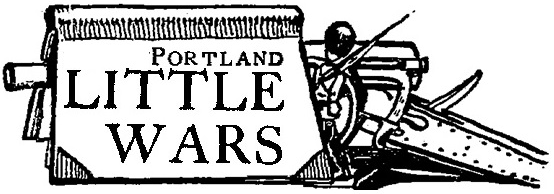The next game was all set up for an action at Rezonville, itself a small part of the battle of Mars le Tour during the Franco-Prussian War. Unfortunately my "wargaming germ pod" co-member bowed out as he had recently come in close proximity to positive Covid test results. Thinking about smaller games that can be played via video conference, I reset the table and tried out the "Blasthof Bridge" scenario from Charge! Or How to Play Wargames (1962) by Charles Grant (1967) by Lawford and Young. If you have ever searched for "old school wargames" or similar, it is highly likely you will find this game featured.
 |
| Starting positions, Allies at bottom, Empire at top. |
In this game, my Imperial (red) troops played the part of the Electoral Army, and my Allied (blues, greens, and greys) that of the Imperial Army from the scenario. Based on the number of figures stated in the scenario, I ended up with:
Allied army:
3 infantry units (5th Cheshire Volunteer Rifles, 2nd Bulgarian infantry, 1st Turkish infantry)
3 cavalry units (S.African Mounted Infantry, Governor General's Horse Guards, 13th Lancers)
2 artillery pieces
 |
| Allies in starting position. |
Imperial Army:
Four regiments of infantry (Irish Guards, 7th Bengal, Scots Guards, West Surrey Line Infantry)
Two squadrons cavalry (2nd Life Guards, 5th Dragoon Guards)
Two artillery.
 |
Empire army in starting position.
|
I used my
Charge! rules variant, with the new additions of (1) no diagonal moves for movement or firing distances and (b) cavalry movement increased to 5 squares. Taking away diagonal moves shortens firing ranges a bit, and the increased cavalry movement makes it possible for a cavalry unit to be out of range of rifle fire, and yet be able to close for melee on a charge. I hoped this prevented cavalry from being shot completely to pieces before doing anything.
 |
| After first moves. |
So it was that both sides pushed their cavalry out on to their flanks at careful distances, while the infantry and artillery trundled more slowly forward in the centers.
 |
13th Lancers ford the river Blast.
|
 |
| Imperial line, 5th Dragoons in foreground. |
 |
After second moves.
|
The Imperials came to decide on the 7th Bengal infantry crossing the river, supported by the Scots Guard and West Surrey, while the Irish Guards and an artillery battery would take positions atop Blasthof hill. The Allies clustered most of their forces around the farm while sending the 13th Lancers and Turkish infantry across the river.
 |
5th Dragoons and Irish Guards move towards hill.
|
There followed some long range artillery and a little rifle fire, with a casualty or two on each side.
 |
After third move.
|
 |
Fourth move.
|
However, both the allied artillery units were able to score long range hits on the Imperial artillery atop Blasthof Hill, reducing it to half strength. This created a perfect opportunity for the Bombay Lancers, so they charged the gun. This caused me to clarify the rules to say that an understrength unit must make two moves to its starting edge
on its turn(s), otherwise players would not be able to exploit situations such as this. Artillery always offers closing fire at close range, but the gun only threw 4 dice due, and scored one hit which was soaked (two hits required at close range to cause a casualty). Artillery crews run when engaged in melee, the the gun was overrun.
 |
13th Lancers take the Imperial gun....
|
The lancers, still at full strength, used their follow-up attack to slam into the Irish Guards (also at full strenth). Units engaged from a follow-up attack do not get closing fire (its chaos!), so it was 10 dice vs 10 dice. Cavalry hits on 4+ and infantry at 5+. Infantry also needs to two hits to cause a cavalry casualty, so the result was great slaughter, with 8 Guardsmen slain (actually 7 slain and 1 taken prisoner) to one lancer.
 |
...and sweep into the Irish Guards...
|
So, at the cost of one lancer, the Allied cavalry were able to take out a gun and an entire unit of infantry!
 |
...and the Irish Guard take heavy casualties and fall back.
|
On the following turn, though, the remaining Imperial artillery scored a good hit on the Turkish infantry (2 casualties), allowing the 5th Dragoons to risk a charge. The closing fire dice were crap so the Dragoons hit the Turks at full strength, routing them.
 |
Dragoons attacking the Turkish infantry.
|
This moved the focus of the battle to the bridge and the farm. The West Surreys gained the bridge and opened fire on allied artillery batteries, while the 7th Bengal fired into the Cheshire Volunteers at close range. Unfortunately Imperial dice rolls were not very good and all this small arms fire did little to the Allied line.




























